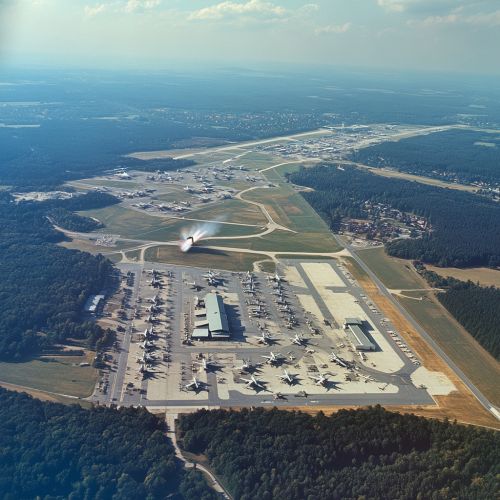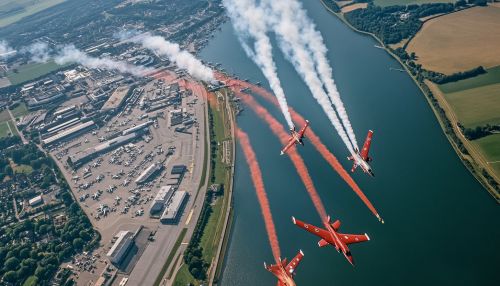Ramstein air show disaster: Difference between revisions
(Created page with "== Ramstein Air Show Disaster == The Ramstein air show disaster was a catastrophic event that occurred on August 28, 1988, during an air show at the Ramstein Air Base in West Germany. This tragic incident involved a mid-air collision of three aircraft from the Italian Air Force aerobatic team, the Frecce Tricolori, resulting in numerous fatalities and injuries among both the pilots and spectators. === Background === The Ramstein Air Base, located near Kaiserslautern i...") |
No edit summary |
||
| Line 15: | Line 15: | ||
On the day of the disaster, the Frecce Tricolori were performing their "pierced heart" maneuver, a signature move involving a heart-shaped formation with a solo aircraft flying through the middle. During the execution of this maneuver, the solo aircraft, piloted by Lieutenant Colonel Ivo Nutarelli, collided with two other aircraft in the formation. | On the day of the disaster, the Frecce Tricolori were performing their "pierced heart" maneuver, a signature move involving a heart-shaped formation with a solo aircraft flying through the middle. During the execution of this maneuver, the solo aircraft, piloted by Lieutenant Colonel Ivo Nutarelli, collided with two other aircraft in the formation. | ||
[[Image:Detail-97861.jpg|thumb|center|An aerial view of the Ramstein Air Base with aircraft performing aerobatic maneuvers.|class=only_on_mobile]] | |||
[[Image:Detail-97862.jpg|thumb|center|An aerial view of the Ramstein Air Base with aircraft performing aerobatic maneuvers.|class=only_on_desktop]] | |||
The collision caused the aircraft to disintegrate mid-air, sending debris into the crowd of spectators. The solo aircraft crashed into the ground, creating a massive fireball and further spreading debris and flames. The impact and subsequent fire resulted in the immediate deaths of 67 spectators and three pilots, with hundreds more injured. | The collision caused the aircraft to disintegrate mid-air, sending debris into the crowd of spectators. The solo aircraft crashed into the ground, creating a massive fireball and further spreading debris and flames. The impact and subsequent fire resulted in the immediate deaths of 67 spectators and three pilots, with hundreds more injured. | ||
Latest revision as of 07:02, 4 September 2024
Ramstein Air Show Disaster
The Ramstein air show disaster was a catastrophic event that occurred on August 28, 1988, during an air show at the Ramstein Air Base in West Germany. This tragic incident involved a mid-air collision of three aircraft from the Italian Air Force aerobatic team, the Frecce Tricolori, resulting in numerous fatalities and injuries among both the pilots and spectators.
Background
The Ramstein Air Base, located near Kaiserslautern in the Rhineland-Palatinate region, has been a significant military installation for the United States Air Force since World War II. The base frequently hosted air shows, which were popular events attracting large crowds. The 1988 air show featured several international aerobatic teams, including the Frecce Tricolori, known for their complex and synchronized aerial maneuvers.
The Frecce Tricolori
The Frecce Tricolori, officially known as the 313° Gruppo Addestramento Acrobatico, is the aerobatic demonstration team of the Italian Air Force. Formed in 1961, the team is renowned for its precision flying and elaborate formations. The team typically flies the Aermacchi MB-339, a military jet trainer aircraft.
The Incident
On the day of the disaster, the Frecce Tricolori were performing their "pierced heart" maneuver, a signature move involving a heart-shaped formation with a solo aircraft flying through the middle. During the execution of this maneuver, the solo aircraft, piloted by Lieutenant Colonel Ivo Nutarelli, collided with two other aircraft in the formation.


The collision caused the aircraft to disintegrate mid-air, sending debris into the crowd of spectators. The solo aircraft crashed into the ground, creating a massive fireball and further spreading debris and flames. The impact and subsequent fire resulted in the immediate deaths of 67 spectators and three pilots, with hundreds more injured.
Emergency Response
The emergency response to the disaster was swift but overwhelmed by the scale of the incident. Medical personnel, both military and civilian, provided immediate assistance, and helicopters were used to transport the severely injured to nearby hospitals. Despite the rapid response, the chaotic scene and the severity of injuries posed significant challenges.
Investigation
An extensive investigation was conducted by both Italian and German authorities, along with the United States Air Force. The investigation focused on the technical aspects of the maneuver, the condition of the aircraft, and the actions of the pilots. It was determined that the collision was primarily due to pilot error during the execution of the complex maneuver.
The investigation also highlighted several safety lapses, including the proximity of the spectators to the performance area and the lack of adequate barriers to protect the audience from potential accidents.
Aftermath
The Ramstein air show disaster had profound implications for air show safety regulations worldwide. In the immediate aftermath, air shows in several countries were canceled or postponed. The disaster led to the implementation of stricter safety protocols, including increased separation between performance areas and spectators, enhanced emergency response plans, and more rigorous training for aerobatic teams.
The disaster also had a lasting impact on the victims and their families. Memorials and commemorations have been held annually to honor those who lost their lives and to remember the tragic event.
Legacy
The Ramstein air show disaster remains one of the deadliest air show accidents in history. It serves as a somber reminder of the inherent risks associated with aerial performances and the importance of stringent safety measures. The lessons learned from this tragedy continue to influence air show regulations and practices to this day.
